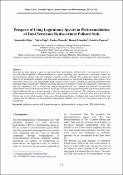Options
Prospects of using leguminous species in phytoremediation of total petroleum hydrocarbons polluted soils
Date issued
2014
Abstract
Selecting the plant species to grow on aged petroleum hydrocarbons polluted soils is an important factor for a
successful phytoremediation. Phytoremediation is a green technology that can become a promising solution for decontaminating polluted soils and ecological restoration of the landscape. Our comparative studies evaluate the effect of oil hydrocarbon pollution with high initial concentration on the growth leguminous plant species: Vicia sativa and Glycine max. The experimental block contains control variants, polluted soil unfertilized/fertilized with municipal sludge anaerobically stabilized in absence/presence of modified volcanic tuff amendment. After period of time the experiment’s soil in which plant species had grown well was sampled and analyzed for petroleum hydrocarbons removal. Both species showed promising efficiency in the phytoremediation of petroleum hydrocarbon highly polluted soils but a reduced growth of the surveyed plants was noticed. The efficiency of the petroleum hydrocarbons diminution is increased in the case of the addition of fertilizer 16.6% for Vicia sativa and 30% for Glycine max vs. the initial quantity. In the case of the phytoremediation of polluted soils treated with fertilizer and volcanic tuff, the efficiency of the petroleum hydrocarbons reduction was 72.9% for Vicia sativa and 53.7% for Glycine max.
successful phytoremediation. Phytoremediation is a green technology that can become a promising solution for decontaminating polluted soils and ecological restoration of the landscape. Our comparative studies evaluate the effect of oil hydrocarbon pollution with high initial concentration on the growth leguminous plant species: Vicia sativa and Glycine max. The experimental block contains control variants, polluted soil unfertilized/fertilized with municipal sludge anaerobically stabilized in absence/presence of modified volcanic tuff amendment. After period of time the experiment’s soil in which plant species had grown well was sampled and analyzed for petroleum hydrocarbons removal. Both species showed promising efficiency in the phytoremediation of petroleum hydrocarbon highly polluted soils but a reduced growth of the surveyed plants was noticed. The efficiency of the petroleum hydrocarbons diminution is increased in the case of the addition of fertilizer 16.6% for Vicia sativa and 30% for Glycine max vs. the initial quantity. In the case of the phytoremediation of polluted soils treated with fertilizer and volcanic tuff, the efficiency of the petroleum hydrocarbons reduction was 72.9% for Vicia sativa and 53.7% for Glycine max.
Files
Loading...
Name
Masu 2014 Leguminoase BDI.pdf
Size
196.69 KB
Format
Adobe PDF
Checksum
(MD5):0cdb1d8f22884955ae64938ffe595355